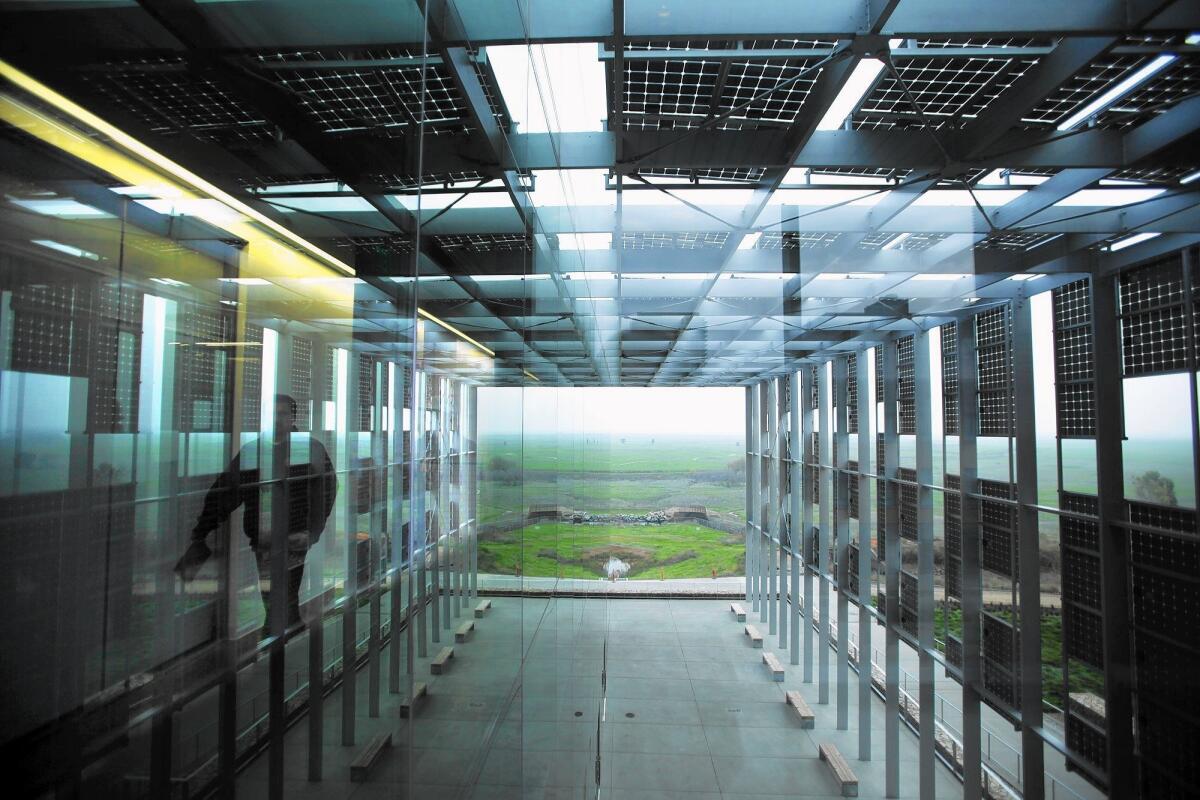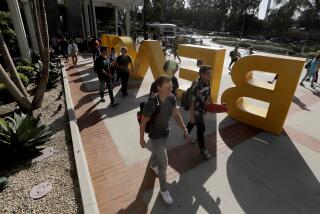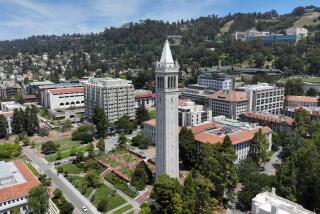To boost admissions of Californians, state should revamp education master plan, report says

A building on the UC Merced campus; a recent report suggests increasing the share of California students eligible to attend UC and Cal State.
- Share via
Many education reformers have long argued that California’s seminal Master Plan for Higher Education is no longer suited to the task of producing millions more college graduates from an increasingly diverse pool of high school students.
The plan, they argue, should be revised to increase the share of students eligible to attend the two four-year public university systems, UC and Cal State, while expanding enrollment and boosting graduation rates.
That idea was renewed recently with the release of a new report by the nonprofit Campaign for College Opportunity that suggests admission to the most popular campuses is out of reach for all but the most qualified students.
Currently, UC is supposed to draw enrollment from the top 12.5% of high school graduates and Cal State from the top 33.3%.
Lawmakers should authorize an increase in those caps to the top 15% of high school graduates at UC and the top 40% at Cal State, the reports suggests.
But is revising the master plan caps feasible and what would such an effort entail? A recent state law requires the director of the state’s Office and Planning and Research to evaluate admission policies of the two systems and determine the number of students eligible for admission. That study is due to be presented to the Legislature a year from now.
Currently, UC admits slightly more than the 12.5% ceiling (nearly 14%) while Cal State admits slightly less than its ceiling, about 32%. The number of students who actually enroll is far fewer.
UC President Janet Napolitano recently proposed to increase enrollment of undergraduates from California by 10,000 by 2018. That is a start, but does not go far enough and doesn’t guarantee long-term expansion, which could occur if the master plan were revised, said Michele Siqueiros, president of the Campaign for College Opportunity.
Cal State is seeking funding in its 2016-17 state budget request to add an additional 12,000 students next year. But that is barely a dent in the 20,000 to 30,000 eligible students who in recent years have been denied admission because of insufficient state funding, officials concede.
Estimates on what it would take for UC and Cal State to reach the higher admission goals is complicated by a number of variables such as the size of the high school graduating class and the ratio of admissions to enrollments. For example, UC officials projected that an additional 7,000 new enrollments would be needed each year.
Cal State has not made a calculation, said spokeswoman Toni Molle, but does not support raising the cap. A significant portion of students admitted now require remedial math and English coursework. Students drawn from a wider pool would probably be even less prepared, Molle said.
The Public Policy Institute of California, though, has endorsed updating the master plan to allow an increase in the share of students eligible for UC and Cal State. A 2010 institute report suggested that such a plan could be phased in over 15 years and at full implementation in 2025 would cost an additional $1.6 billion annually.
An October update from the San Francisco-based institute suggests that by 2030, the state will have 1.1 million fewer college-educated workers than the economy will require.
“Making room for these highly capable students — by increasing the share of high school graduates eligible for the University of California and the California State University systems — would improve the well-being of our state and the lives of these young Californians,” said senior fellow and study author Hans Johnson.
Johnson said both systems would need to increase freshman admissions by about 20%, as well as increase graduation rates and transfer students to reach targets.
UC officials said lifting the enrollment cap is a worthy goal, but would be complicated by aging facilities and infrastructure, would require vastly more funding than the state is likely to give and would take years to accomplish.
“If the state made the decision to revise that part of the master plan ... we’d do everything we could to do that,” said Nina Robinson, UC’s associate president and chief policy advisor. “But that would mean funding for capital that we don’t have right now. It’s hard to imagine that we could educate another 50,000 in the same facilities we have now. Those are challenges that could be met over time. It takes 10 years to finance, plan and build a new building.”
And campuses must count the costs of providing students with services, once enrolled, said Cal State’s Assistant Vice Chancellor Eric Forbes.
“We all want to serve students, there is no desire not to do that,” Forbes said. “ But we need to do it well and provide the opportunity for students to move from course to course, from term to term and from year to year to complete their programs.”
Educators say that both systems must increase efforts to reduce the time it takes to finish a degree, which can also free space for new enrollments. UC, for example, is creating three-year bachelor’s degree programs in many of its popular majors. A draft long-range plan at Cal State proposes year-round academic schedules for many campuses.
Any improvement could not come soon enough for Lynda McGee, a counselor at Downtown Magnets High School in Los Angeles. It’s gotten harder for students — even with excellent grades — to enroll in UC and their local Cal State campus. She is advising them to apply to private and out-of-state colleges.
“I understand there are many pulls on our state economy, but I don’t think the Legislature looks at educating our youth as being as important as a rainy-day fund, and I do,” McGee said. “These are the students that are going to keep our economy running 20 years from now.”
Twitter: @carlariveralat
ALSO
Faculty call new Cal State background checks intrusive
Coalition calls for greater focus on computer science in UC, Cal State admissions
Affirmative action at universities in doubt as U.S. Supreme Court hears arguments
More to Read
Sign up for Essential California
The most important California stories and recommendations in your inbox every morning.
You may occasionally receive promotional content from the Los Angeles Times.











